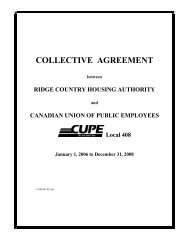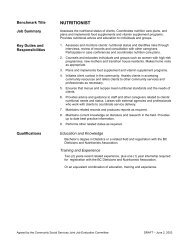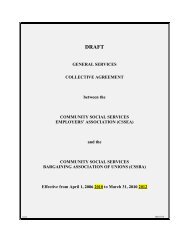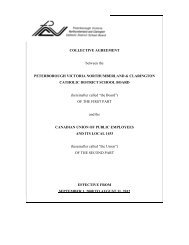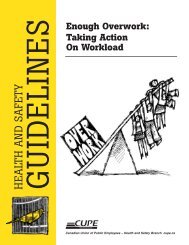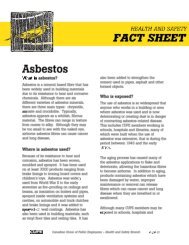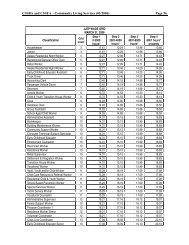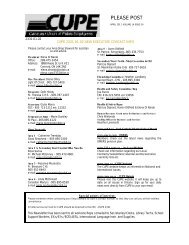Community Living Services Collective Agreement - British Columbia ...
Community Living Services Collective Agreement - British Columbia ...
Community Living Services Collective Agreement - British Columbia ...
You also want an ePaper? Increase the reach of your titles
YUMPU automatically turns print PDFs into web optimized ePapers that Google loves.
CSSBA and CSSEA - <strong>Community</strong> <strong>Living</strong> <strong>Services</strong> (03/2012) Page 93<br />
5. Wage Rate<br />
5.1 Each benchmark and unique job will be assigned to a classification grid. Each classification grid<br />
has a corresponding wage rate, which is listed in the <strong>Collective</strong> <strong>Agreement</strong>. For example (note:<br />
this is for illustrative purposes only):<br />
Benchmark Title: Residence Worker Classification grid: 10<br />
6. Principles of Classification<br />
6.1 The JJEP is used to rate benchmarks and unique jobs and thereby establish their point value rating<br />
and relative value.<br />
6.2 The purpose of benchmarks is to establish the means whereby jobs may be properly classified and<br />
distinguished. To that end a job should be classified on the basis of best fit according to the<br />
overall type of duties and scope and level of responsibilities which are performed to an extent<br />
material for a reasonable standard of job classification.<br />
6.3 Unique jobs are rated using the JJEP and assigned to a classification grid in accordance with their<br />
point value rating.<br />
6.4 Where the parties identify essentially similar duties and responsibilities for a group of unique<br />
jobs, a benchmark will be created.<br />
6.5 Integrated Jobs: Where a job encompasses work in two or more benchmarks, and where it is<br />
administratively impractical to keep track or even identify when the incumbent is working within<br />
one or the other of the classifications, the job will be classified at the highest classification of the<br />
jobs being performed.<br />
6.6 Special Licences And Certificates: Where the employee is required by the Employer to carry a<br />
special licence, certificate or qualification, she should be classified consistently with such licence,<br />
certification or qualification.<br />
6.7 Incumbent employees in positions who do not possess the qualifications set out in the benchmark<br />
to which their jobs have been matched will continue to be so classified as long as they continue to<br />
occupy the jobs.<br />
6.8 Jobs are classified only by comparison to the benchmarks and not by comparison to other jobs.<br />
6.9 Throughout the whole process of evaluating jobs, it is the job that is evaluated and not the<br />
employee.<br />
6.10 Layering Over: Supervisors and lead hands must be compensated at a rate higher than those they<br />
supervise or lead. Where this cannot be accomplished by classification to an existing benchmark,<br />
positions designated as layered over will be compensated at a rate of two additional grids above<br />
the highest position supervised for positions at pay grade 12 or below OR one additional grid for<br />
those positions at pay grade 13 or above. A supervisor or lead hand, for the purpose of this article,<br />
is defined as a worker who reviews, assigns and monitors the work of other assigned workers.<br />
7. Glossary of Terms<br />
(The parties agree that the Glossary of Terms is outstanding and is yet to be discussed.)<br />
SCHEDULE A<br />
Benchmark Class Specifications and Job Families<br />
Administrative, Finance & Technical<br />
Accountant, Accounting Clerk, Administrative Assistant, Administrative Supervisor, Bookkeeper,







